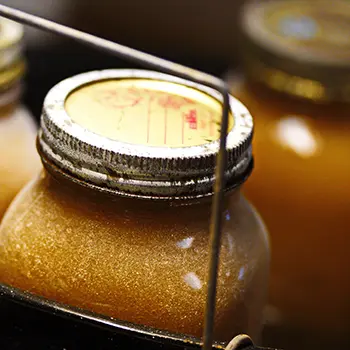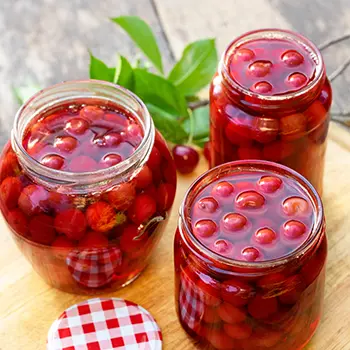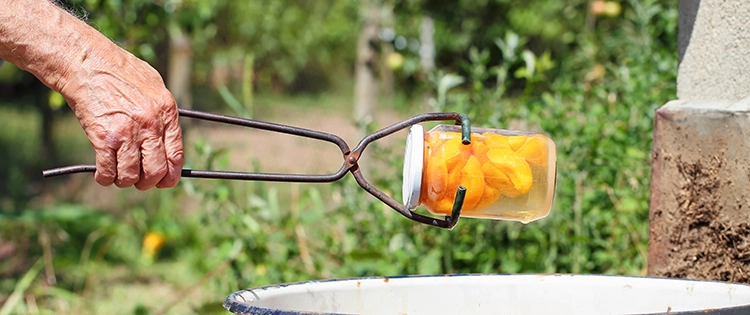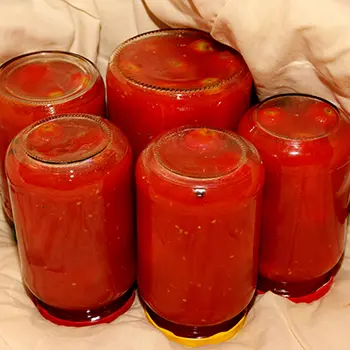When you want to can your favorite produce, water bath canning is the best way to do it. However, it’s not meant for all foods because the food is processed at a lower temperature than a pressure canner.
Therefore, it is most effective for foods that are highly acidic which is mainly fruits and vegetables that have been pickled. The pickling process is required to raise their acidity levels. Spend a few hours canning your favorite fruits and vegetables and you’ll have all the ingredients required for delicious home-cooked meals and snacks at your fingertips.
Here are ten foods that are safe to preserve in a water bath canner.
What is Water Bath Canning?
Water bath canning is a popular method used for food preservation. It involves adding sealed jars of high-acidic foods to boiling water. The high temperature destroys mold, yeast, and any harmful microorganisms that can cause spoilage. The vacuum seal prevents the entrance of new contaminants, ensuring food is preserved over the long term. High levels of acid create an environment where it is impossible for harmful bacteria such as Clostridium botulinum to thrive.
Water bath canning is a cost-effective method that allows people to enjoy seasonal produce throughout the year. The process preserves the flavor and nutritional benefits of the foods. Once the jars are ready, store them in a cool, dry, dark place such as a cellar or a pantry. These foods can be stored for 1 to 1.5 years.
10 Foods That Are Safe For Water Bath Canning
Applesauce: Applesauce delights the taste buds with its perfect balance of sweet and tart flavors. Adding spices such as cinnamon makes it even more delicious. Applesauce is simple, yet delicious and tasty, why not spoil yourself and have it at your fingertips all year round by canning it. A strainer makes the canning process a lot easier. You don’t need to peel or core the apples, simply chop them up and you can start the canning process.
Relish: Relish is a pickled mixture of garlic, spices, onions, and cucumbers. It is a much-loved staple in a lot of households. Canning it will ensure you have a steady supply all year round.
Related:10 Canning Recipes From The Amish
Pickled Vegetables: When most people think of pickles, they think of cucumbers. However, you can pickle all vegetables, and you will need to do this to make them safe to water bath. This is because vegetables are low-acid foods and require the high heat from a pressure can to process them safely. Nevertheless, there are some vegetables that are safe for water bath canning because they are packed with vinegar. For example, dilly beans, but although tomatoes are acidic, they are risky so you will need to raise the acid level by adding vinegar or lemon juice to them. Whatever your favorite vegetables are, pickle them before canning them. But make sure you follow the exact instructions for the pickling recipe or your vegetables won’t be safe for water bath canning.
Berries: Whether blueberries, raspberries, strawberries, or blackberries, you can can them for winter baking, or if you fancy a quick snack, eat them straight out of the jar.
Related: Canning Mistakes Even The Most Advanced Homesteaders Make
Cherries: These beautiful crimson-red delights are a must-have on your canning list.  I would advise that you make a batch with the pits in and one without. In this way, you can use the pitless cherries for a pie filling, and the other just because you enjoy eating cherries.
I would advise that you make a batch with the pits in and one without. In this way, you can use the pitless cherries for a pie filling, and the other just because you enjoy eating cherries.
Pie Filling: What are your favorite pie fillings? Apple, pear, blueberries, or peaches? You can use these for pastries, desserts, and a range of tasty treats that will help satisfy your sweet tooth.
Fruit Preserves: You can make preserves and jams to spread over toast, bagels, and anything else that you fancy. There is a wide range of fruit preserves you can can including, strawberry jam, cherry preserves, blueberry compote, raspberry jelly, and peach preserves.
Tomato Sauce: As mentioned, tomatoes will need a boost of acid to be considered safe for water bath canning. You can achieve this by adding vinegar or lemon. Again, follow the recipe exactly as it is written and you’ll have delicious tomato sauce to enjoy throughout the year.
Related: Fermenting vs Pickling
Juice: Fruit juices provide an abundance of vitamins and minerals, and they also add variety to our diet. Juice can be used for drinks and desserts. Juices you can water bath can include:
- Tomato juice

- Pineapple juice
- Pear nectar
- Peach nectar
- Grapefruit juice
- Grape juice
- Cranberry juice
- Blackberry cordial
- Apricot nectar
- Apple juice
Peaches: These summer fruits are awesome for water bath canning! They need to sit in a naturally sugary substance, so you can either use half juice and half water, or a natural sugar syrup. You can either slice the peaches or cut them in halves before canning.
Tips For Water Bath Canning
- You need to use new lids each time you can. It’s fine to reuse the bands if they are in good condition. Simmer lids for 10 minutes at 180 F to activate the compound responsible for the vacuum seal.
- Choose produce that is ripe, but not too ripe or bruised to ensure the best quality.
- Find the right guidelines for water bath canning because it is a very scientific process and it can be complicated for the layman. The National Center for Home Preservation and The Department of Agriculture will provide you with a lot of insightful information.
- Water bath can recipe instructions must be followed exactly as they are set out to ensure the food maintains its pH level. The ingredients become unsafe when the pH level is too low or too high.
- Label each jar with the date of processing and its contents.
- Store the jars away from direct sunlight in a cool, dry place. Don’t stack the jars on top of each other because this can rupture the seal of the lid.
- Become a part of the canning community by getting in touch with other canners through groups on social media.
If you follow the instructions from trusted sources, you can’t go wrong with water bath canning. It’s a great way to preserve your favorite fruits and vegetables so that they’ll be available to you whether they’re in or out of season.
You may also like:
Pioneer Recipes Every Homesteader Should Learn
An Insanely Effective Way to Build a 5 Year Food Stockpile (Video)
25 Pantry Foods That Actually Expire Quickly















